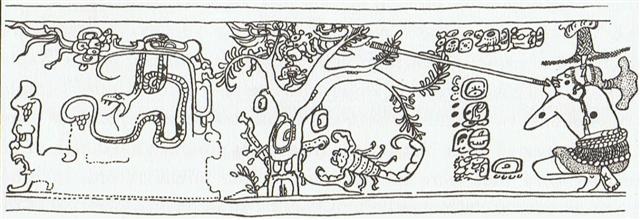484.
These 6 glyphs in the C text have been listed in my
glyph type catalogue as
belonging in the type koti (GD66):
 |
 |
 |
 |
 |
 |
|
Ca3-12 |
Ca7-24 |
Ca9-9 |
Cb6-6 |
Cb6-22 |
Cb14-8 |
Our investigation has so far provided
us with evidence suggesting
koti means a place for the
beginning of a new season of
light. The 'bird' has here
broken through his 'egg-shell'
(excepting at Ca7-24 where his
confinement is still intact):
| Nov 21 (325) |
22 |
128 |
March 30 (89) |
43 |
| May 22 |
23 (143) |
Sept 29 (2 * 136) |
 |
 |
 |
| Ca3-11 |
Ca3-12 (63) |
Ca7-24 (192) |
| kua hua |
ki te kotiga |
te hare pure e tagata noho ki roto |
| BEID |
HYADUM I (63.4 = 41.4 + 22.0) |
MIMOSA |
| 348 / 2 = 174 = 6 * 29 = 236 - 62 |
| May 13 (133) |
14 (366 + 134 = 500) |
98 |
Aug 21 (233) |
56 |
Oct 17 (290) |
| Nov 12 |
13 (317) |
Febr 20 (51) |
April 17 (107) |
 |
 |
 |
 |
| Ca9-8 (236) |
Ca9-9 |
Ca12-20 (336 = 4 * 84) |
Cb1-1 (393) |
| ku tupu te poporo |
kotia |
kua moe |
First Point of Aries |
| 314 / 2 = 157 |
SHERATAN (27.4 = 63.4 - 36.0) |
| 393 + 349 = 742 = 1½ * 366 + 193 |
| 174 |
157 |
136 |
200 |
75 |
= 742 (= 14 * 53) |
| 348 |
314 |
272 |
400 |
150 |
= 1484 |
| *268 |
*234 |
*192 |
*320 |
*70 |
= *1000 + *84 |
| 522 |
471 |
408 |
600 |
225 |
= 2226 |
| 2226 = 1½ * 1484 = 6 * 371 = 42 * 53 = 159 fortnights |
| 120 |
 |
15 |
 |
199 |
 |
11 |
zero |
62 |
| Cb6-6 (63 + 450) |
Cb6-22 (63 + 466) |
Cb14-8 (63 + 666) |
| 272 / 2 = 136 |
400 / 2 = 200 = 336 - 136 |
150 / 2 = 75 |
...
Long
ago in the very beginning of
time there dwelt within a shell
an infant god whose name was
Ta'aroa. He was Ta'aroa
the unique one, the ancestor of
all gods, the creator of the
universe whose natures were
myriad, whose backbone was the
ridgepole of the world, whose
ribs were its supporters. The
shell was called Rumia,
Upset. Becoming aware at last of
his own existence and oppressed
by a yearning loneliness
Ta'aroa broke open his shell
and, looking out, beheld the
black limitless expanse of empty
space. Hopefully, he shouted,
but no voice answered him. He
was alone in the vast cosmos.
Within the broken Rumia
he grew a new shell to shut out
the primeval void ...

The egg toth enabling a
chicken to burst out into the
open is the only tooth a bird
ever will have, and this poweful
tool seems to be lost afterwards.
"All successful
human action is preceded by
right knowledge. Therefore this
(knowledge will be here)
investigated ... if the subject
matter were of no use, no work
could be devoted to an enquiry (pratipatti
= bstan-pa), just as no
reasonable man would ever
undertake an enquiry about the
teeth of a crow ..." (F. Th.
Stcherbatsky, Buddhist Logic).
|
18 |
Hairy Head |
η Tauri (Alcyone) |
Cockerel |
May 16 (136) |
|
19 |
Net |
ε Tauri (Ain) |
Crow |
May 25 (145) |
Possibly this
can cast some light on the peculiar event when
Itzam-Yeh lost his
beautiful shining tooth - after
which he no more would be able
to break through, no more would
be able to
alight in the top of the Tree
(Rakau):
... This pot depicts one of the
Hero Twins (One-Ahaw in the
Classic texts and One-Hunaphu in
the K'iche' Popol Vuh)
and a great bird who is trying
to land in a huge ceiba tree
heavy with fruit. This mythical
bird is Itzam-Yeh,
Classic prototype of
Wuqub-Kaqix, 'Seven-Macaw',
of Popol Vuh fame. In
that story, in the time before
the sky was lifted up to make
room for the light, the
vainglorious Seven-Macaw
imagined himself to be the sun.
Offended by his pride, the Hero
Twins humbled him by breaking
his beautiful shining tooth with
a pellet from their blowgun ...

It could imply his
beautiful shining tooth would
anyhow return in the next great cycle. At present Dubhe
(α) is far from the north pole.
In the diagram below the observer is located at
the north pole (90º
N) with α Ursae Minoris
(Polaris) in the zenith. The
position in time is
AD 1842-03-21 18.00 when Auriga
and Orion were in the south:
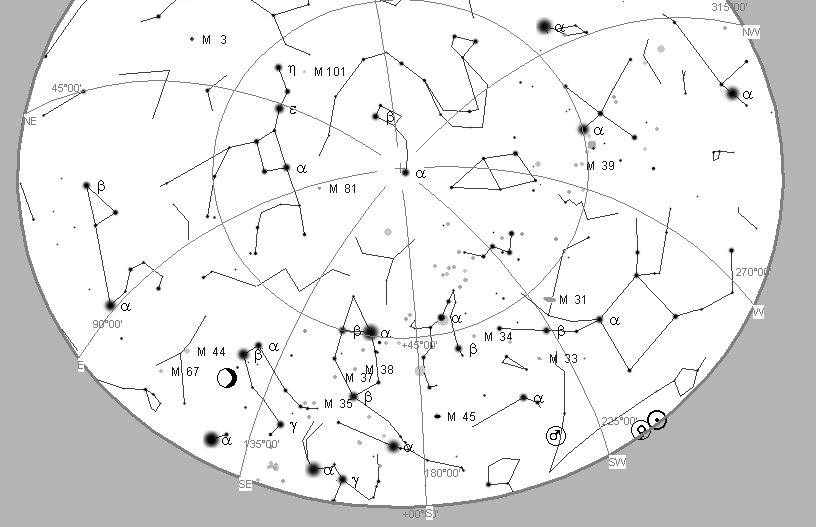
Gemini was in the
southeast (SE) and Leo was due east
(E). To the right of Auriga we
can see
Perseus and further up
Cassiopeia.
Ursa Major was
between Leo and Ursa Minor, with
Dubhe at declination 62º
01' N. Menkalinan (β Aurigae,
44º 57') was marking the
declination line for 45º N and
Mintaka (the Belt, δ Orionis,
00º 20' S) the declination line
for 0º. Only the right arm of
Virgo was visible, at 45º (NE).
Where is the
Itzam-Yeh bird? Our
constellation lines are not
necessarliy the same as those of
other peoples, and a quick look at the
perceptions of the Chinese is
sobering:
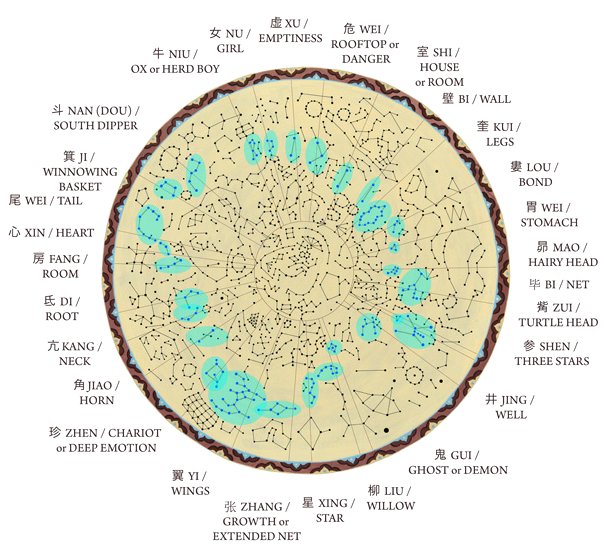
Although we can
recognize the green-marked constellations
as
our own zodiac the polar region has
far more stars than we are
accustomed to see, and Ursa
Major is not evident. But we
could
try to gradually
include fainter stars:

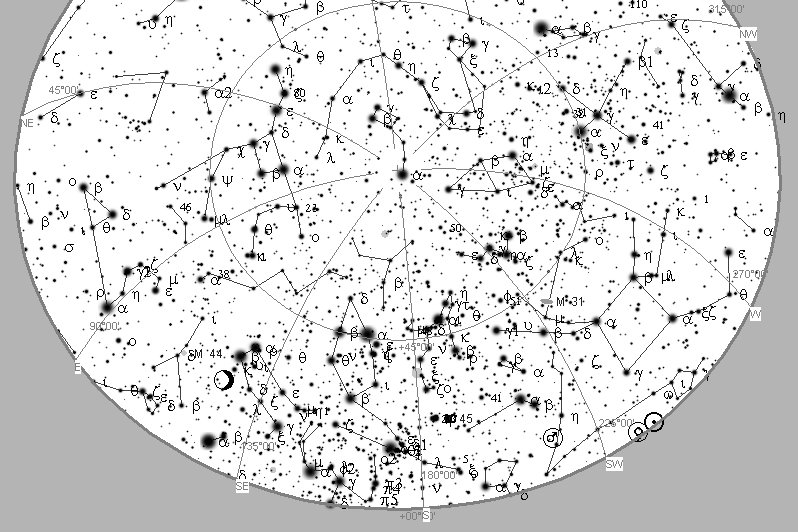
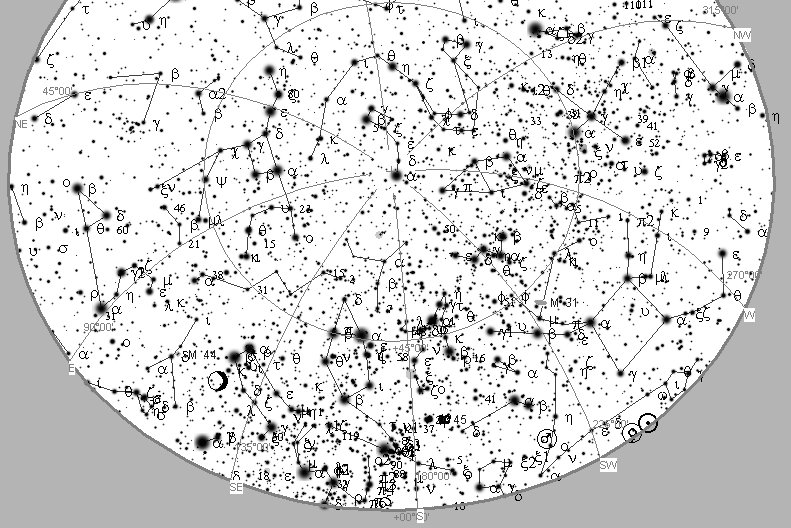
This seems to be
of no help. Then we can compare
with the ancient Babylonian
view:

No bird can be
seen at the central position at
the top. But far down below
Gemini (Great Twins)
there was a perching bird
(possibly corresponding to the
Red Bird of the Chinese).
In the year 3149
BC (28 May) Itzam-Yeh was
defeated. Let's look at where
Ursa Major was at that ancient
time:

Here it becomes
clear that Dubhe could hardly
have been
the tooth of Itzam-Yeh.
Instead his tooth ought to refer to the
Fox star Al-cor (The
Heart, 3.99):
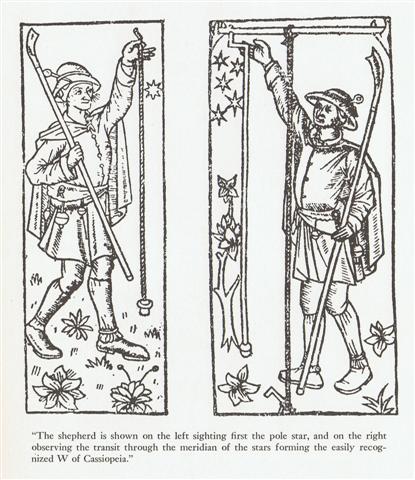
... In the inscriptions of
Dendera, published by Dümichen,
the goddess Hathor is
called 'lady of every joy'. For
once, Dümichen adds: Literally
... 'the lady of every heart
circuit'. This is not to say
that the Egyptians had
discovered the circulation of
the blood. But the determinative
sign for 'heart' often figures
as the plumb bob at the end of a
plumb line coming from a
well-known astronomical or
surveying device, the merkhet.
Evidently, 'heart' is something
very specific, as it were the
'center of gravity' ... See
Aeg.Wb. 2, pp. 55f. for sign of
the heart (ib) as
expressing generally 'the
middle, the center'. And this
may lead in quite another
direction. The Arabs preserved a
name for Canopus - besides
calling the star Kalb
at-tai-man ('heart of the
south') ... Suhail el-wezn,
'Canopus Ponderosus', the
heavy-weighing Canopus, a name
promptly declared meaningless by
the experts, but which could
well have belonged to an archaic
system in which Canopus was the
weight at the end of the plumb
line, as befitted its important
position as a heavy star at the
South Pole of the 'waters
below'. Here is a chain of
inferences which might or might
not be valid, but it is
allowable to test it, and no
inference at all would come from
the 'lady of every joy'. The
line seems to state that
Hathor (= Hat Hor,
'House of Horus') 'rules' the
revolution of a specific
celestial body - whether or not
Canopus is alluded to - or, if
we can trust the translation
'every', the revolution of all
celestial bodies. As concerns
the identity of the ruling lady,
the greater possibility speaks
for Sirius, but Venus cannot be
excluded; in Mexico, too, Venus
is called 'heart of the earth'.
The reader is invited to imagine
for himself what many thousands
of such pseudo-primitive or
poetic interpretations must lead
to: a disfigured interpretation
of Egyptian intellectual life
...
... The Arabs in the desert
regarded it as a test of
penetrating vision; and they
were accustomed to oppose 'Suhel'
to 'Suha' (Canopus to
Alcor) as occupying respectively
the highest and lowest posts in
the celestial family. So that
Vidit Alcor, et non lunam plenum,
came to be a proverbial
description of one keenly alive
to trifles, but dull of
apprehension for broad facts
...
From Canopus
(*95) to Alcor (*202) there were
107 right ascension days, equal
to for instance the difference
between 471 (= 3 * 314 / 2) and
364 (= 91 weeks).
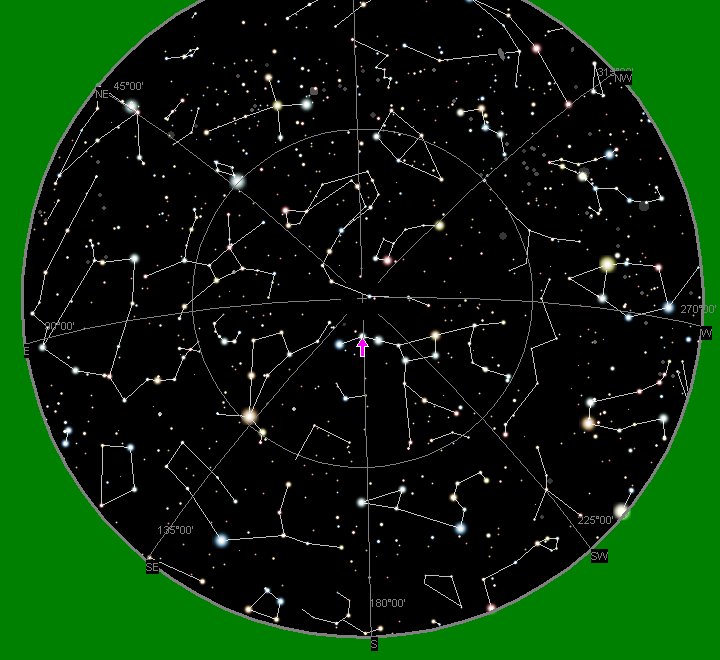
Itzam-Yeh
was defeated and instead the
place at the top of the world
(the Tooth) had been taken over by Thuban
(α Draconis, 3.67):

... Snorri Sterluson explains
why 'Frodi's grist' is a kenning
for gold. Frodi ruled during a
peaceful and productive period,
contemporaneous with Augustus's
Pax Romana and the birth
of Christ; hence the kenning.
There were neither thieves nor
robbers during this period, 'so
that a gold ring lay long on
Jalang's heath'. Snorri
continues his account with the
legend of the mill beyond what
is told in the song: The girls'
grinding produced an army
hostile to Frodi. On the very
day of the girls' predictions,
the sea-king, Musing (Son of the
Mouse), landed on the Danish
shore, killed Frodi, and took
away Grotti and the women on his
ship. The girls were bidden to
grind out salt on the mill. At
midnight they asked for further
instructions. 'Keep grinding',
he told them. Then they ground
with such vigor that the ship
sank. Water poured into the eye
of the mill, creating the
maelstroem of the sea. Therefore
the sea was salt. Incidentally,
the mill was given a kenning,
Serpent's
Couch ...
... Thuban had been the star at
the North Pole when the great
Egyptian pyramids where built.
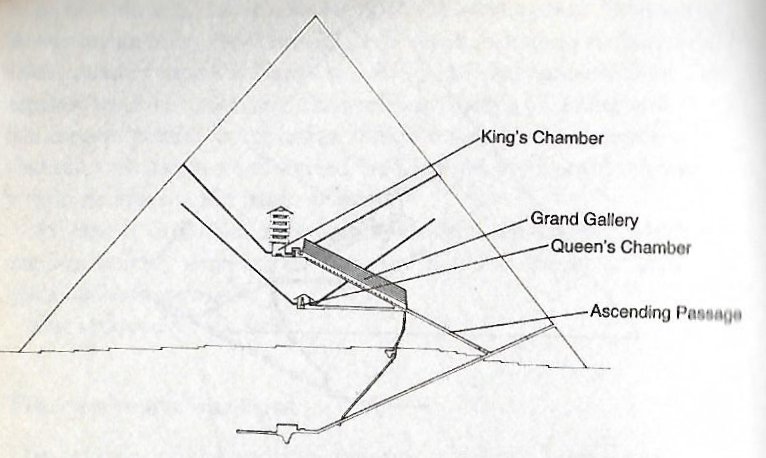
... The star could be seen, both
by day and night, from the
bottom of the central passage of
the Great Pyramid of Cheops (Knum
Khufu) at Ghizeh, in 30° of
north latitude, as also from the
similar points in five other
like structures; and the same
fact is asserted by Sir John
Herschel as to the two pyramids
at Abousseir
...
... Proclus informs us that the
fox star nibbles continuously at
the thong of the yoke which
holds together heaven and earth;
German folklore adds that when
the fox succeeds, the world will
come to its end. This fox star
is no other than Alcor,
the small star g near zeta Ursae
Majoris (in India Arundati,
the common wife of the Seven
Rishis, alpha-eta Ursae)
...
|
5 |
Heart |
σ Scorpii |
Fox |
Nov 23 (327) |

From the
thong between heliacal Spica
and Alcor to the end of side
a - with Polaris at the Full
Moon - there were 8 days
(similar to the 8 black days
between Venus as Evening
Star and Venus as Morning
Star:
|
CIRCUIT OF VENUS |
|
Evening Star |
263 |
|
Black |
8 |
|
Morning Star |
263 |
|
Black |
50 |
|
Sum |
584 |
|
te kihikihi |
o te henua -
kua haga
hia |
kua pua |
te vero |
te henua |
kiore - te
henua |
|
Pua.
1. A
zingiberacea
(plant of which
few specimens
are left on the
island). 2.
Flower: pua
ti, ti
flower, pua
taro, taro
flower, pua
maúku
pasture flower;
pua nakonako,
a plant which
grows on steep
slopes and
produce red,
edible berries.
3. Pua tariga
(or perhaps
pu'a tariga),
anciently, hoops
put in earlobes.
4. The nanue
fish when
young and
tender.
Puapua,
summit, top,
upper part;
te puapua o te
maúga, the
top of the
mountain; te
puapua kupega,
the upper
part of a
fishing net.
Vanaga.
Pu'a.
1. (Modern form
of pu'o),
to cover up
something or
oneself, to put
on; ka-pu'a
te ha'u, put
on your hat;
ka-pu'a-mai te
nua, cover
me up with a
blanket. 2. To
respond to the
song of the
first group of
singers; to sing
the antistrophe;
he-pu'a te
tai. 3. To
help; ka-pu'a
toou rima ki a
Timo ite aga,
help Timothy
with the work.
4. Pu'a-hare,
to help a
relative in war
or in any need;
ka-oho,
ka-pu'a-hare
korua, ko ga
kope, go,
give your
relative a hand,
lads. 5. To
speak out in
someone's
favour; e
pu'a-mai toou
re'o kia au,
speak in my
favour,
intercede for
me. Pu'apu'a,
to hit, to beat.
Vanaga. 1.
Flower, ginger,
soap; pua
mouku,
grass. 2. To
grease, to coat
with tar, to
pitch; pua ei
meamea, to
make yellow.
Puapua, a
piece of cloth.
Mgv.: pua,
a flower,
turmeric,
starchy matter
of the turmeric
and hence soap.
Mq.: pua,
a flower, soap.
Ta.: pua,
id. Ma.:
puapua,
cloth wrapped
about the arm.
Churchill. |
 |
 |
 |
 |
 |
 |
|
*Ca14-12 (366 +
9) |
*Ca14-13 → 182 |
*Ca14-14 (393 -
16) |
*Ca14-15 (378) |
*Ca14-16 |
*Ca14-17 (396 -
16) |
|
... The ordinary
year in the
previous Roman
calendar
consisted of 12
months, for a
total of 355
days. In
addition, a
27-day
intercalary
month, the
Mensis
Intercalaris,
was sometimes
inserted between
February and
March. This
intercalary
month was formed
by inserting 22
days after the
first 23 or 24
days of
February; the
last five days
of February,
which counted
down toward the
start of March,
became the last
five days of
Intercalaris.
The net effect
was to add 22 or
23 days to the
year, forming an
intercalary year
of 377 or 378
days ... |
|
CLOSE TO THE
FULL MOON: |
|
ξ
Phoenicis (9.0),
ρ
Tucanae (9.1),
DENEB KAITOS
(Tail of the Sea
Beast) = β Ceti,
η
Phoenicis (9.4),
AL NITHĀM
(String of
Pearls) =
φ¹
Ceti
(9.6)
*334 = *375.4 -
*41.4 |
ACHIRD (Woman
with Luminous
Rays) =
η
Cassiopeiae
(10.7)
|
Legs-15 (Wolf)
ν
Andromedae
(11.0),
φ²
Ceti (11.1),
ρ
Phoenicis
(11.2),
η
Andromedae
(11.4)
*336 = *377.4 -
*41.4 |
CIH (Whip) = γ
Cassiopeiae,
λ Tucanae
(12.4), φ³ Ceti
(12.6), μ
Andromedae
(12.8)
*12.4 + *366
-*41.4 = *337 |
φ4 Ceti (13.2) |
no star listed
(14) |
|
... The king,
wearing now a
short, stiff
archaic mantle,
walks in a grave
and stately
manner to the
sanctuary of the
wolf-god
Upwaut, the
'Opener of the
Way', where he
anoints the
sacred standard
and, preceded by
this, marches to
the palace
chapel, into
which he
disappears. A
period of time
elapses during
which the
pharaoh is no
longer manifest.
When he
reappears he is
clothed as in
the Narmer
palette, wearing
the kilt with
Hathor belt
and bull's tail
attatched. In
his right hand
he holds the
flail scepter
and in his left,
instead of the
usual crook of
the Good
Shepherd, an
object
resembling a
small scroll,
called the Will,
the House
Document, or
Secret of the
Two Partners,
which he
exhibits in
triumph,
proclaiming to
all in
attendance that
it was given him
by his dead
father Osiris,
in the presence
of the earth-god
Geb. 'I
have run', he
cries, 'holding
the Secret of
the Two
Partners, the
Will that my
father has given
me before Geb.
I have passed
through the land
and touched the
four sides of
it. I traverse
it as I desire.'
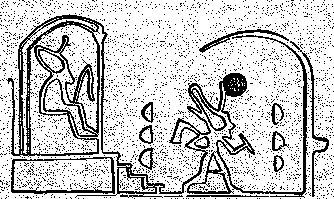 |
|
... The month, which takes its name from Juppiter the oak-god, begins on June 10th and ends of July 7th. Midway comes St. John's Day, June 24th, the day on which the oak-king was sacrificially burned alive. The Celtic year was divided into two halves with the second half beginning in July, apparently after a seven-day wake, or funeral feast, in the oak-king's honour ...

|
| te honu paka |
te henua |
honu kau |
te mata |
te honu |
kua heheu |
|
Paka. 1. Dry; to become dry (of things); pakapaka, to dry out. Te paka is also the name of the moss-covered areas, between the small lakes of volcano Rano Kau, through which one can pass without getting one's feet wet. 2. To go, to depart; he-paka-mai, to come; he-oho, he-paka, they go away. 3. To become calm (of the sea): ku-paka-á te tai. Pakahera, skull, shell, cranium; pakahera puoko tagata, human skull; pakahera pikea, shell of crab or crayfish. Gutu pakapaka, scabbed lips. Hau paka, fibres of the hauhau tree, which were first soaked in water, then dried to produce a strong thread. Moa gao verapaka, chicken with bald neck. Ariki Paka, certain collateral descendents of Hotu Matu'a, who exercised religious functions. Vanaga. 1. Crust, scab, scurf; paka rerere, cancer; pakapaka, crust, scabby. 2. Calm, still. 3. Intensive; vera paka, scorching hot; marego paka, bald; nunu paka, thin. 4. To arrive, to come. 5. To be eager. 6. To absorb. 7. Shin T. Pakahera, calabash, shell, jug. Pakahia, to clot, curdle, coagulate. Pakapaka, dry, arid, scorching hot, cooked too much, a desert, to fade away, to roast, a cake, active; toto pakapaka, coagulated blood; hakapakapaka, to dry, to broil, to toast. Pakahera pikea, shell of crab or crayfish. Churchill. |
 |
 |
 |
 |
 |
 |
| *Ca14-18 |
*Ca14-19 |
*Ca14-20 (77 + 306) |
(6 + 378) |
*Ca14-22 |
*Ca14-23 |
| CLOSE TO THE FULL MOON: |
| 5 (159 + 302) |
6 (462 - 366 = 96) |
April 7 |
8 |
9 (465) |
10 (100) |
| 9 (132 + 302) |
10 (435 - 366 = 69) |
'March 11 |
12 |
13 |
14 (73) → π |
| "Febr 23 (6 * 70) |
24 (462 - 41 = 421) |
25 |
26 |
27 (*345) |
28 (59 = 2 * 29½) |
| 31 (95 + 302) |
1 (398 - 366 = 32) |
FEBR 2 |
3 |
4 |
5 (100 - 64) |
|
... the Palenque scribes repeated Creation again and described it as 'it was made visible, the image at Lying-down-Sky, the First-Three-Stone-Place'. Then we learned that five hundred and forty-two days later (1.9.2 in the Maya system), Hun-Nal-Ye 'entered or became the sky' (och ta chan). This 'entering' event occurred on February 5, 3112 BC ... |
| DEC 7 |
8 |
9 |
10 |
(345 = 162 + 183) |
12 (*266) |
| 1h (15.2)
β Phoenicis (15.1), υ Phoenicis, ι Tucanae (15.6), η Ceti, ζ Phoenicis (15.7)
*79 + *302 - *366 = *15 |
Al Batn Al Hūt-26 (Belly of the Fish) / Revati-28 (Prosperous) / 1-iku (Field Measure)
MIRACH (Girdle) = β Andromedae, KEUN MAN MUN (Camp's South Gate) = φ Andromedae (16.0), ANUNITUM = τ Piscium (16.5), REVATI (Abundant) = ζ Piscium (16.9)
REGULUS (α Leonis) |
ν Phoenicis (17.4), κ Tucanae (17.6)
*342.0 = *383.4 - *41.4 |
no star listed (18) |
ADHIL (Garment's Train) = ξ Andromedae (19.3), θ Ceti (19.7) |
KSORA (Knee) = δ Cassiopeiae (20.1), ω Andromedae (20.6), γ Phoenicis (20.8) |
|
... Though Andromeda has its roots most firmly in the Greek tradition, a female figure in Andromeda's place appeared in Babylonian astronomy. The stars that make up Pisces and the middle portion of modern Andromeda formed a constellation representing a fertility goddess, sometimes named as Anunitum or the Lady of the Heavens ...
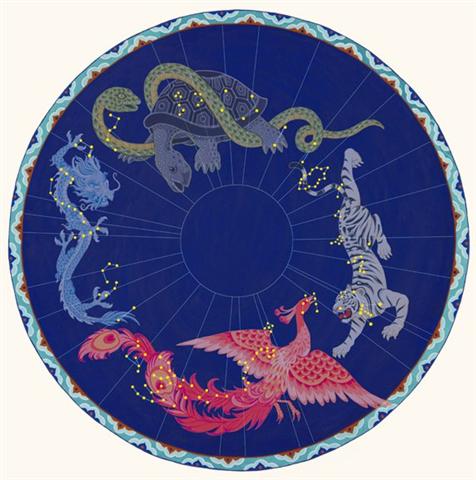
|
| CLOSE TO THE SUN: |
| 6 (342 + 302 - 365) |
7 (*200) |
8 (281) |
Oct 9 |
10 |
11 (284) |
| "Aug 26 |
27 |
28 (*80 * 2 = *160) |
29 (241 = 282 - 41) |
30 |
31 |
| JUNE 7 |
8 |
9 (*160 - *80 = *80) |
10 (161 = 241 - 80) |
11 |
12 |
| AL DAFĪRAH (Tuft) = β Com. Ber. (199.4)
*158.0 = *199.4 - *41.4 |
σ Virginis (200.4)
*159.0 = *200.4 - *41.4 |
γ Hydrae (201.0), ι Centauri (201.4)
*160.0 = *201.4 - *41.4 |
Al Simāk-12 (Lofty) / Chitra-14 (Bright One) / Horn-1 (Crocodile) / Sa-Sha-Shirū-20 (Virgin's Girdle) / ANA-ROTO-3 (Middle pillar)
MIZAR = ζ Ursae Majoris (202.4), SPICA = α Virginis, ALCOR = 80 Ursae Majoris (202.7)
SADALMELIK (α Aquarii)
*161.0 = *202.4 - 41.4 |
71 VIRGINIS (203.6) |
no star listed (204) |
 |
| te henua |
te honu kau |
manu kake rua |
te henua |
te honu |
te rima |
|
Kake. Kakea, to come near, to embark. P Pau.: kake, to climb, to ascend. Mgv.: kake, the arrival of shoals of spawning fish. Mq.: kake, to climb up a valley. Ta.: ae, to climb, to ascend. Churchill. Mgv.: kake, to strike on an ocean reef. Ta.: ae, to strand. Churchill. Sa.: a'e, upward, to go up; sa'e, to elevate one leg, as in the act of falling in a club match; 'a'e, to ascend, to rise. To.: hake, upward, to ascend. Fu.: ake, up, to ascend; sake, ro raise the leg at one in derision or mockery; kake, to climb, to ascend. Niuē: hake, up, going up. Uvea: ake, up; kake, to go up. Ma.: ake, upward; kake, to climb, to ascend. Mq.: ake, on high, upward; kake, to ascend. Mgv.: ake, upward. Bukabuka: ake, up. Ta.: ae, up, to go up, to ascend, to climb. Ha.: ae, to raise, to lift up, to mount. Fotuna: no-jikijiake, to lift up; no-tukake, to stand upright. Nukuoro: kake, to go up. Nuguria: kake, up; hanage, northwest. Rapanui: kake a, to go abroad. Vi.: thake, upward; thaketa, to dig or lift up. Churchill 2. |
 |
 |
 |
 |
 |
 |
| *Ca14-24 |
*Ca14-25 → 350 |
*Ca14-26 |
*Ca14-27 (390) |
*Ca14-28 |
*Ca14-29 |
| CLOSE TO THE FULL MOON: |
| δ Phoenicis (21.5)
*79 + *308 - *366 = *21 |
PINWHEEL GALAXY (M33 Trianguli) (22.1), υ Andromedae (22.9) |
ACHERNAR (End of the River) = α Eridani (23.3), χ Andromedae (23.6), τ Andromedae (23.9) |
ALSEIPH (Scimitar) = φ Persei (24.5), τ Ceti (24.7) |
no star listed (25) |
ANA-NIA-10 (Pillar-to-fish by)
χ Ceti (26.1), POLARIS = α Ursae Minoris, BATEN KAITOS (Belly of the Fish) = ζ Ceti (26.6), METALLAH (Triagle) = α Trianguli (26.9) |
 |
| 11 (159 + 308 - 366) |
April 12 (286 - 184) |
13 (468 = 365 + 103) |
14 (104 = ☼20) |
15 |
16 (392 - 366 + 80) |
| "March 1 (60) |
2 |
3 |
4 (104 - 41 = 63) |
5 |
6 |
| 13 (347 = 164 + 183) |
DEC 14 |
15 |
16 |
17 |
18 (*272) |
|
ALSEIPH (Scimitar) = φ Persei |
|
October 15 |
288 |
*208 |
|
April 14 |
288 + 181 |
*390 |
|

... You are the one who shall stay here. We, on the other hand, have to turn around. Makoi replied, All right with me! Then Ira continued to speak to Makoi: Tomorrow, when it grows light, set out and name the places beginning with Apina. Makoi replied, How shall I give the names? Again Ira spoke, In Hiva are the names that are to be taken to name (the places of the new land). It grew light and Makoi got up. He set out and came to Apina. When he arrived there, he gave the name This is Apina Iti, this is Rapa Kura. He went on and came to Hanga O Ua. He gave the name This is Hanga O Ua of the Beautiful Wave (vave renga). Makoi went on, giving names, until he had made a (complete) circle around both sides (of the island). In Apina Nui a stone (maea) was erected, saying that the naming was done on a (round) trip during a single day ...
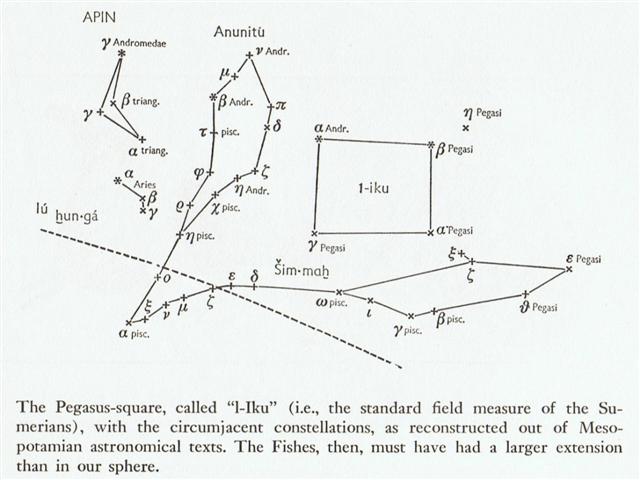
|
| CLOSE TO THE SUN: |
| 12 (342 + 308 - 365) |
Oct 13 (286) |
14 |
15 (288 = ☼204) |
16 |
17 (392 + 80 - 182) |
| 1 (244 = 285 - 41) |
Hora Nui 2 |
3 (*166) |
4 |
(☼164 = ☼84 + ☼80) |
6 |
| JUNE 13 (164) |
14 (*85) |
15 (166) |
16 |
(☼84 = ☼164 - ☼80) |
18 (352 - 183) |
... Hotu's canoe sailed from Maori to Te Pito O Te Kainga. It sailed on the second day of September (hora nui) ... (E:74)
|
| HEZE = ζ Virginis (205.0), Southern Pinwheel Galaxy = M83 Hydrae (205.7) |
ε Centauri (206.3), κ Oct. (206.4)
*165.0 = *206.4 - *41.4 |
no star listed (207) |
τ Bootis (208.2), BENETNASH (Leader of the Daughters of the Bier) = η Ursae Majoris (208.5), ν Centauri (208.7), μ Centauri, υ Bootis (208.8) |
no star listed (209) |
MUPHRID (Solitary Star) = η Bootis (210.1), ζ Centauri (210.3) |
|


